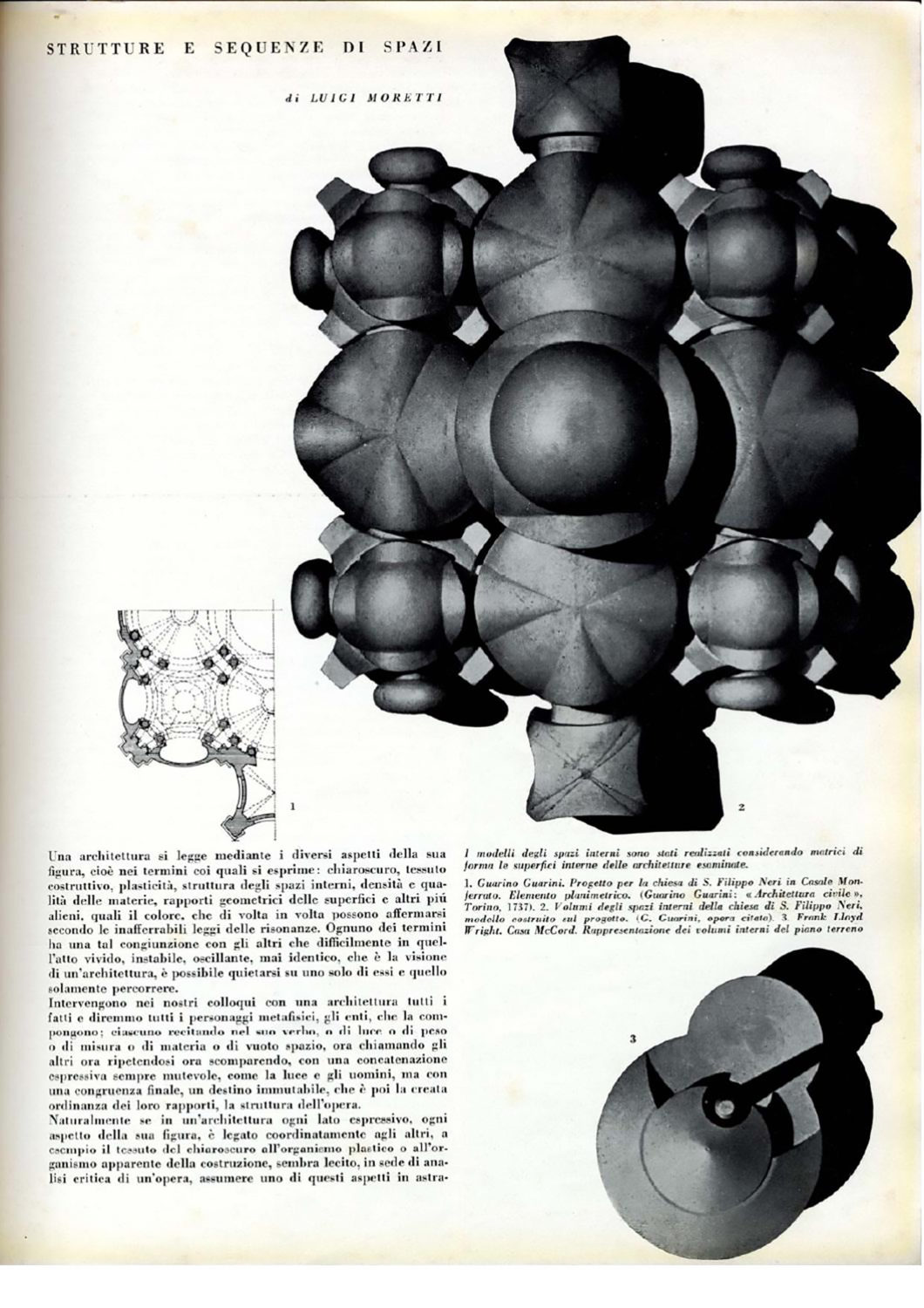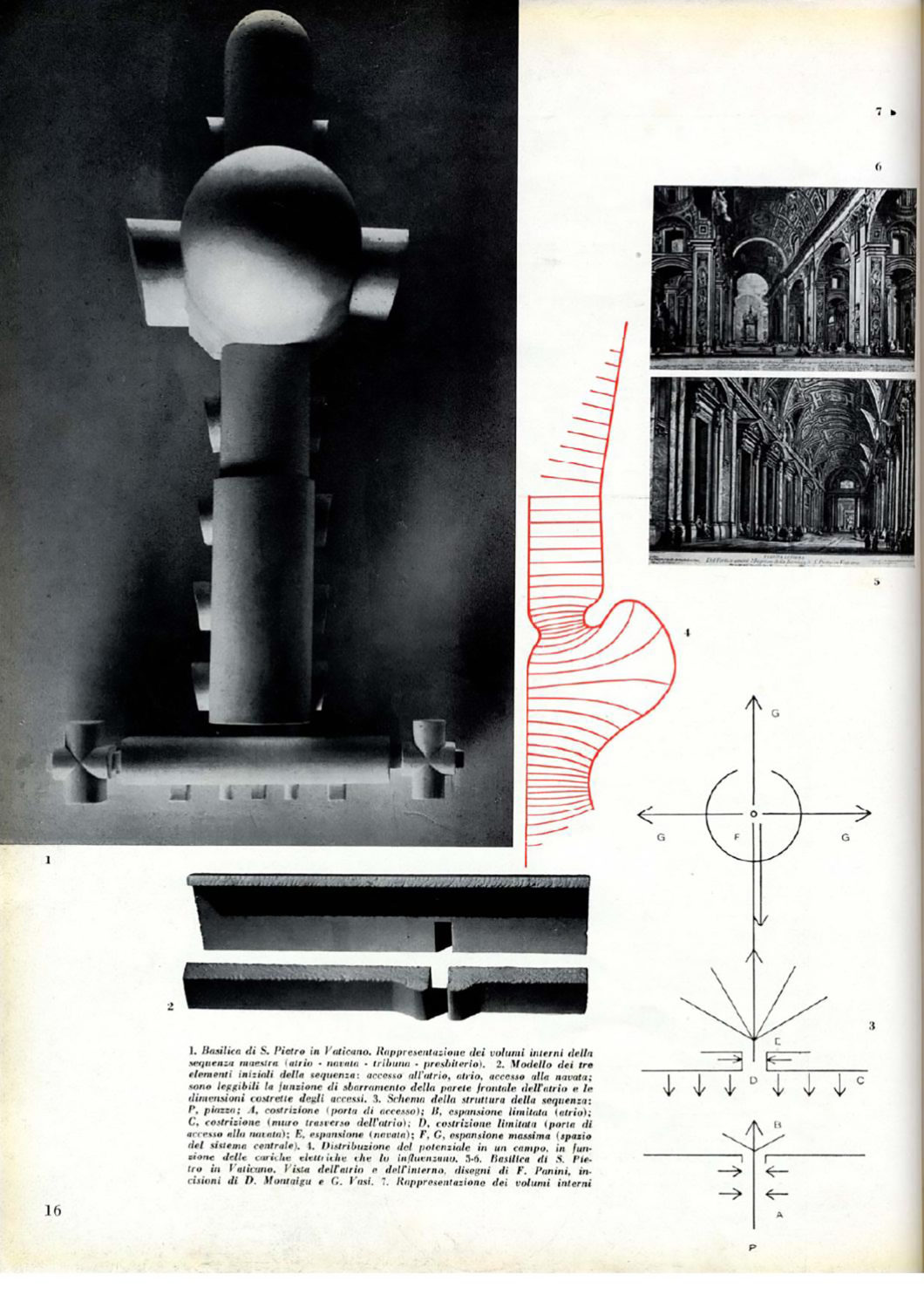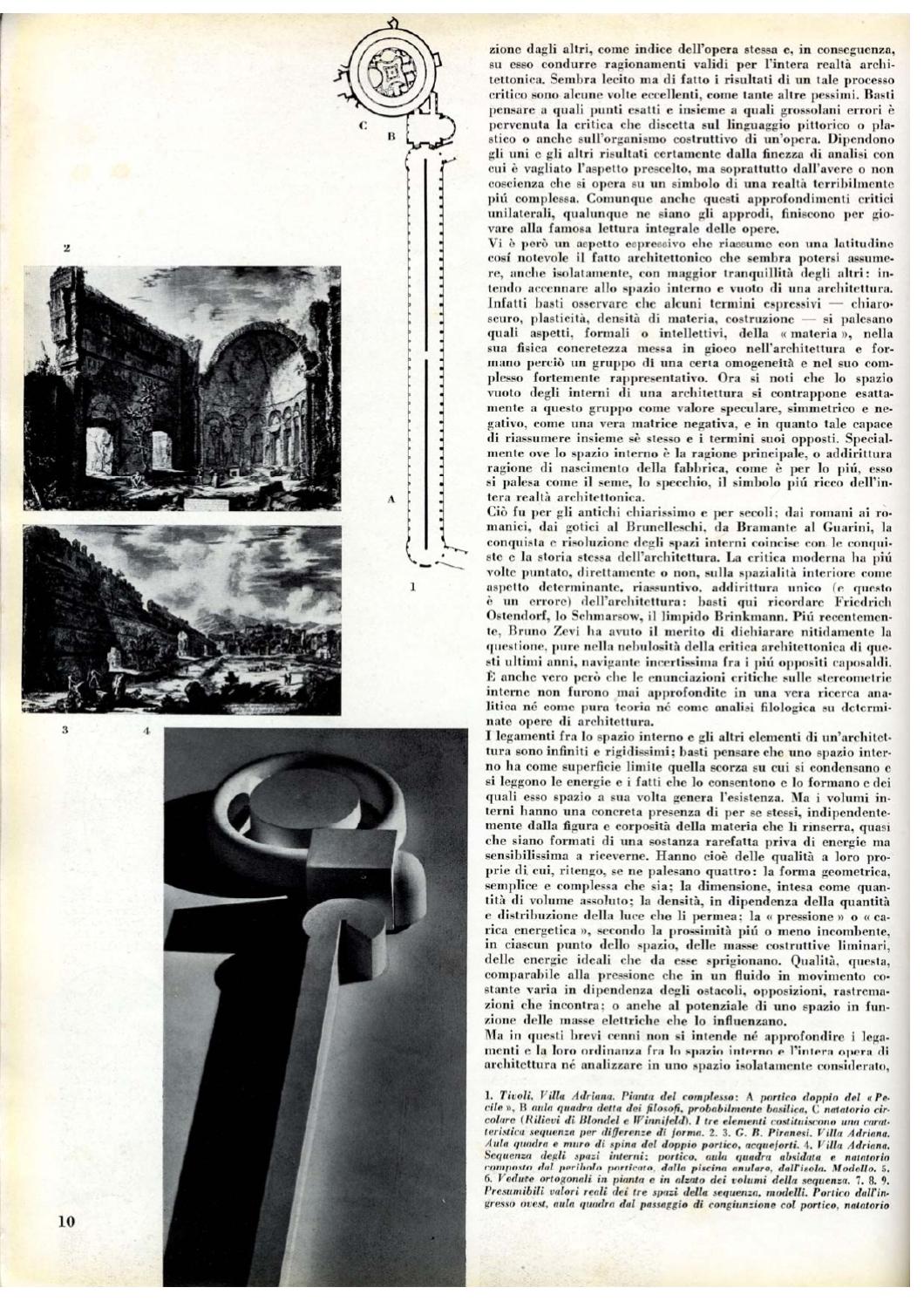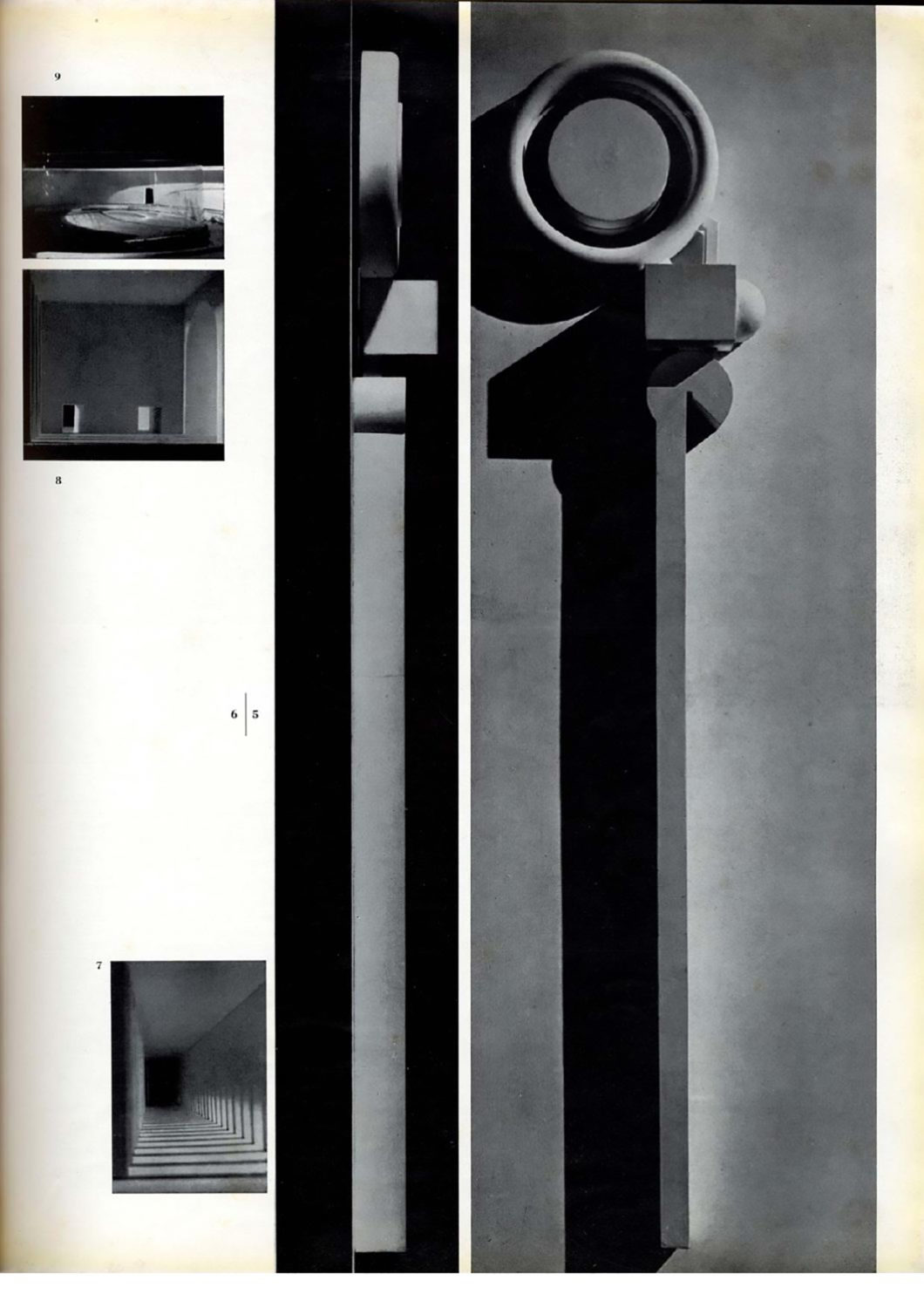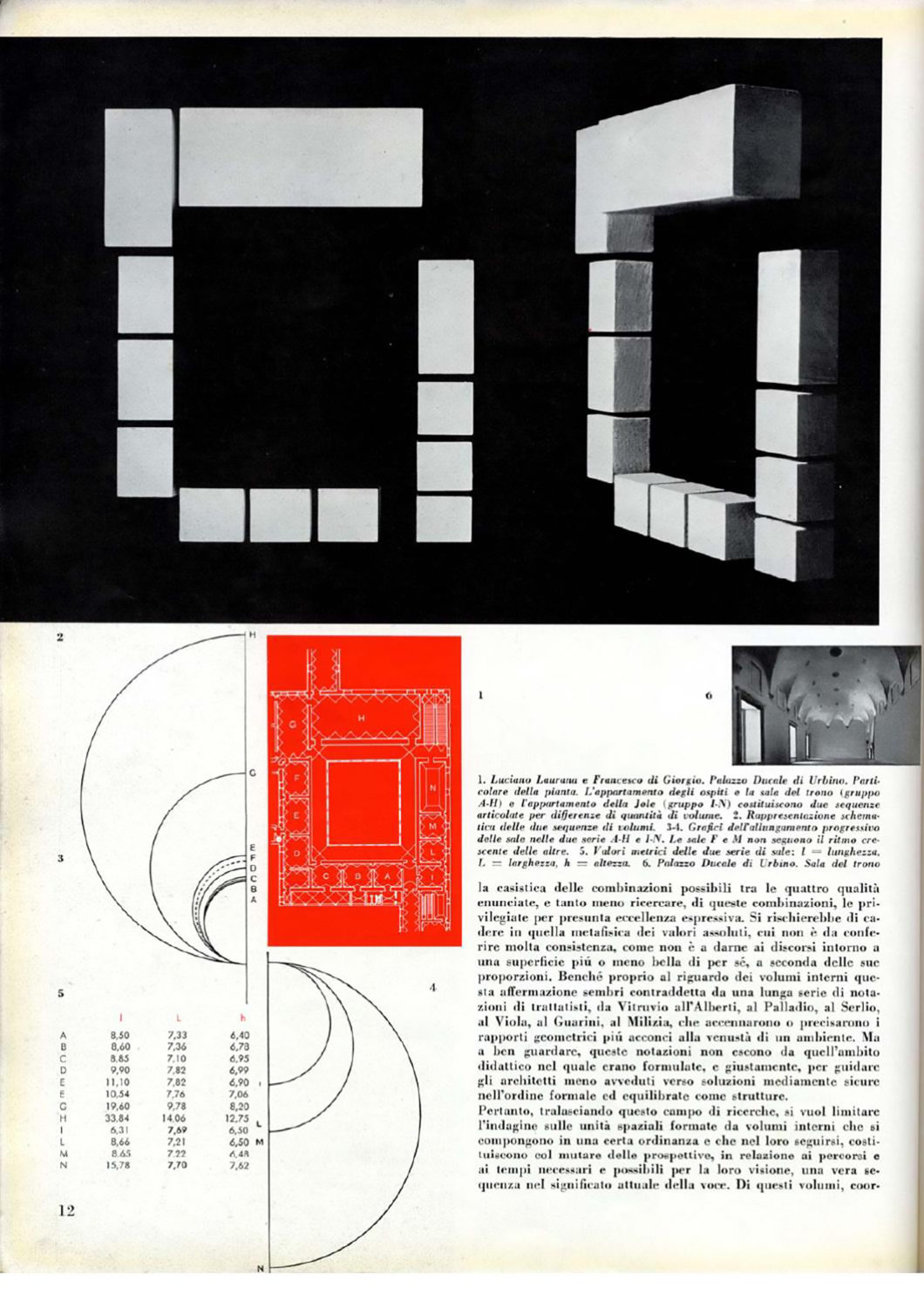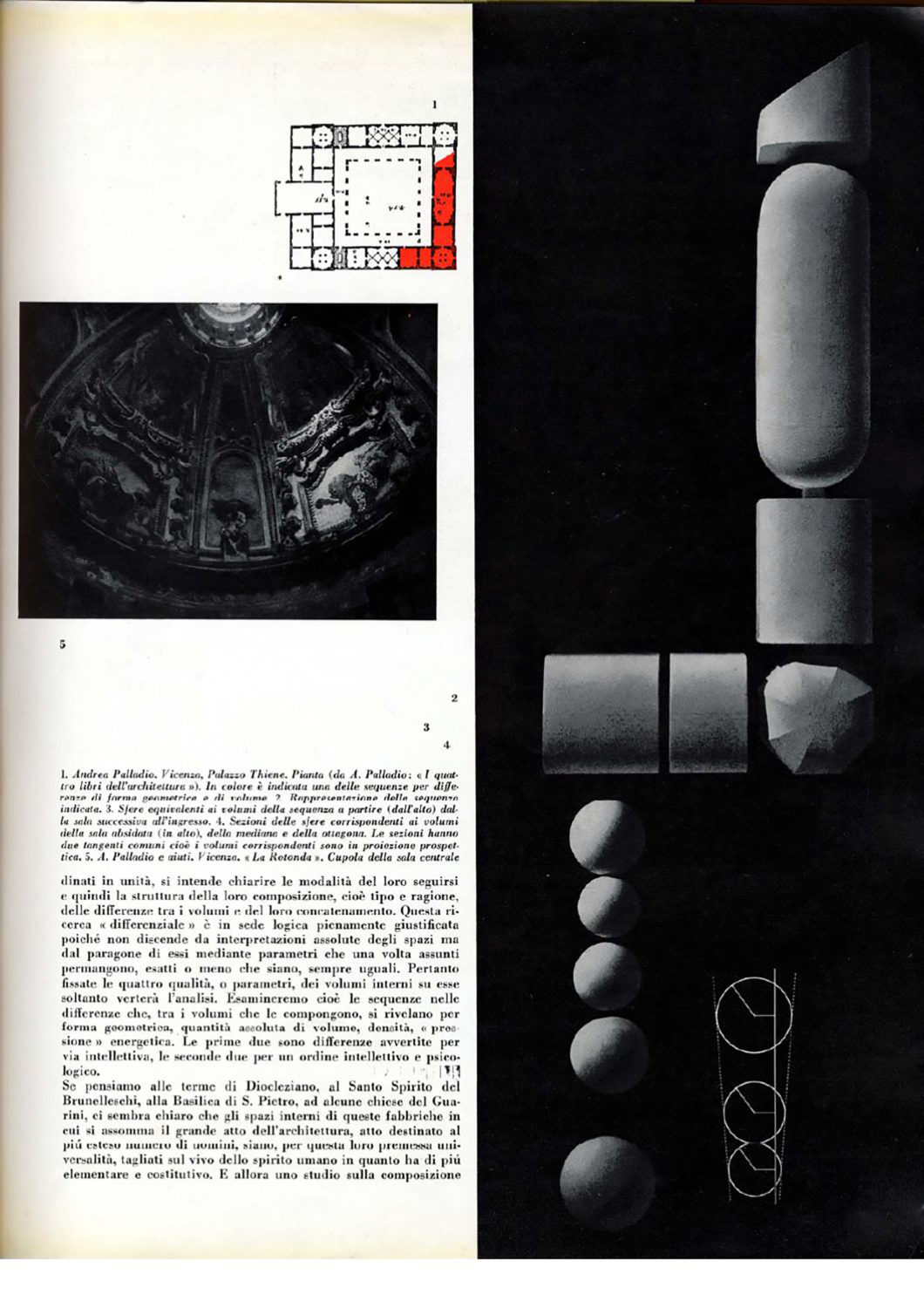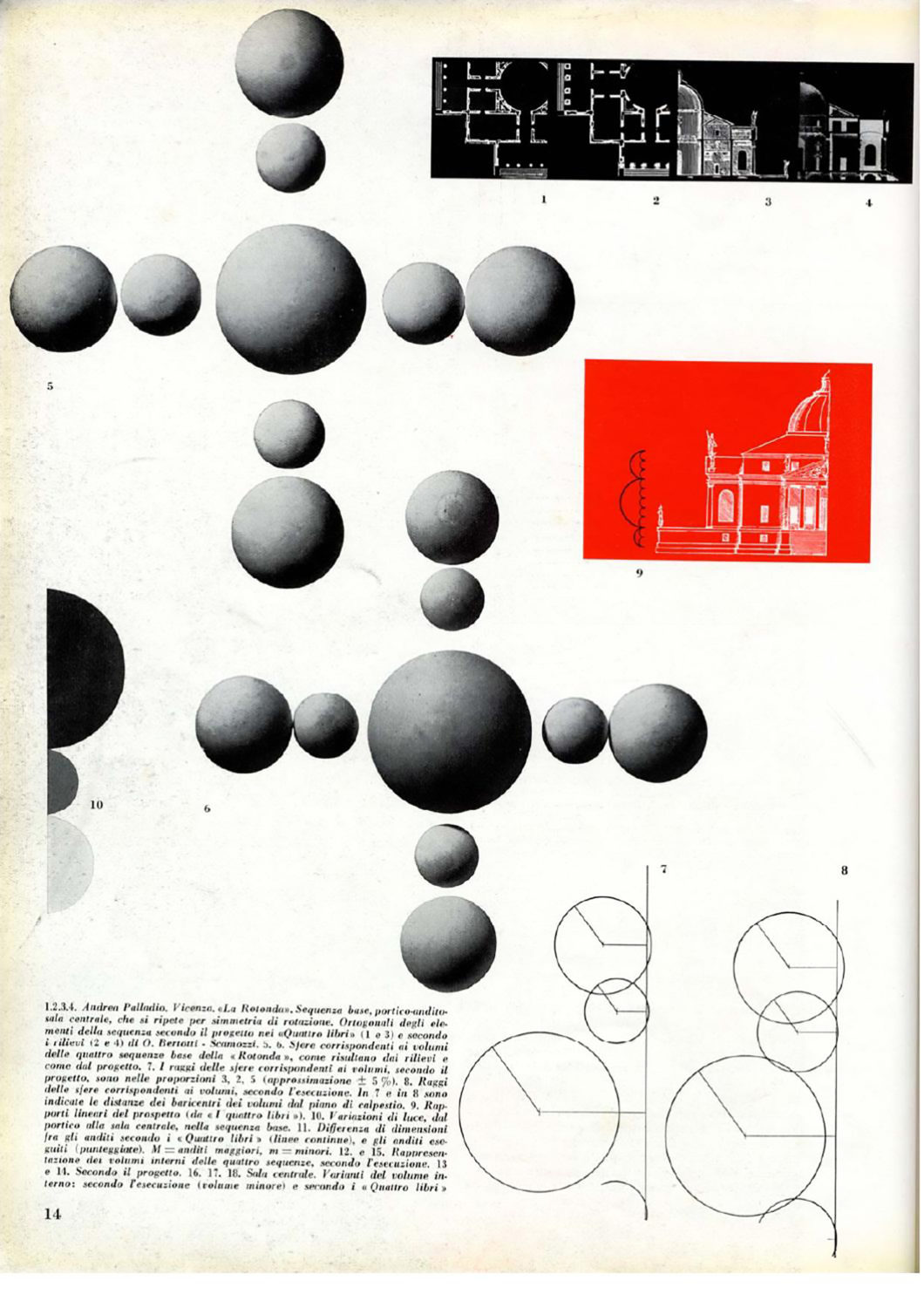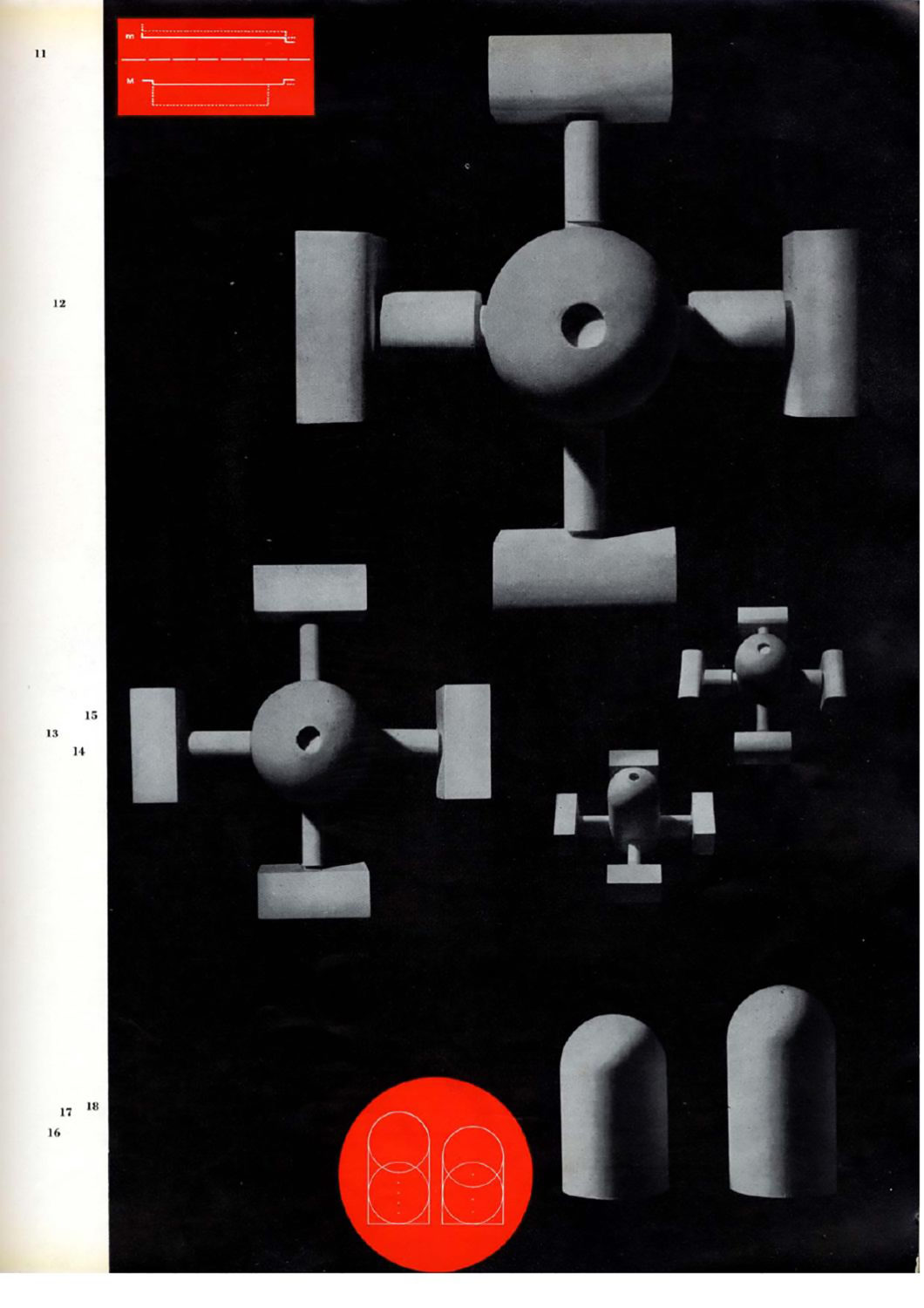Author: admin
The Italian architect Luigi Daneri (1900-1972) studied at Genua and after the WW2 he participated in the INA-CASA, the reconstruction of housing in Italy. The Italian state established a program of building houses for workers, in order to give jobs to workers: the realization of the plan was entrusted to NA Assitalia SpA, an insurance company.
Hs is most known for his work on the co-ordination of the architectural design for parts of the INA-Casa district for 4,500 inhabitants called Forte Quezzi in Genoa (1956-1958). Forte Quezzi
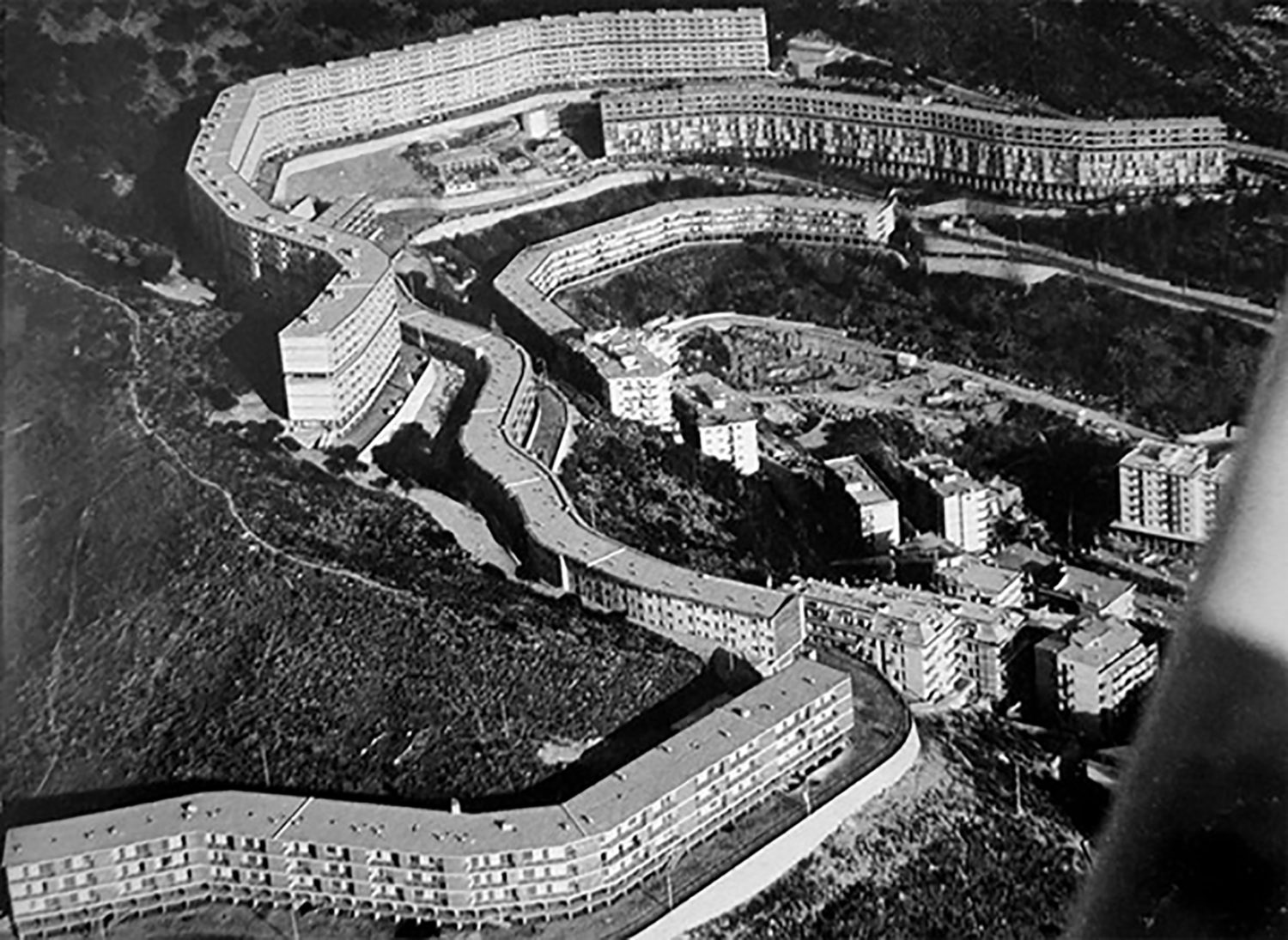
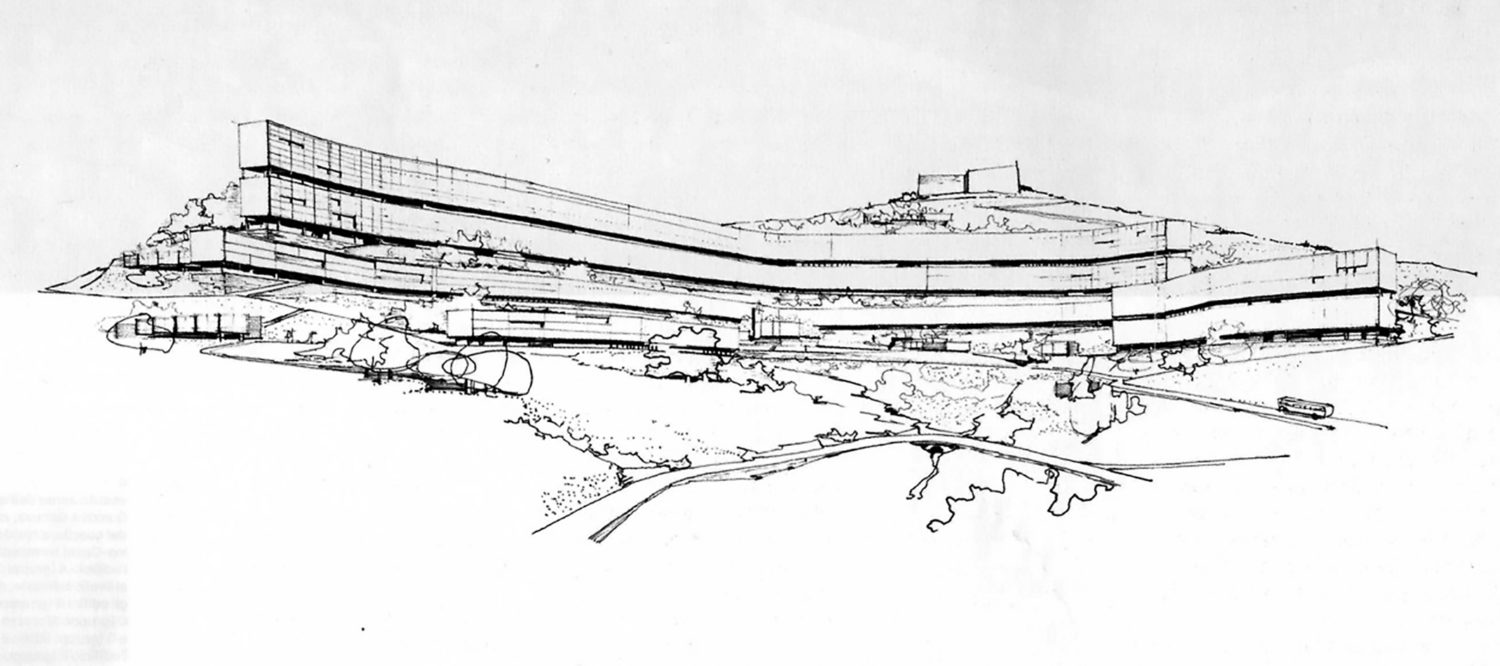
Il Biscione, Forte Quezzi, 1956-1958
Umberto Eco, (1932-2016) was an internationally acclaimed writer, philosopher, medievalist, professor, and the author of the best-selling novels Foucault’s Pendulum, The Name of the Rose, and The Prague Cemetery.
His numerous nonfiction books include Six Walks in the Fictional Woods, Confessions of a Young Novelist, and The Open Work.
His book The Open Work is still considered significant for its concept of an openness in art (and architecture) —the creator’s decision to leave certain arrangements of a work open to the public to chance and to complete the work.
It embraces the element of multiplicity and plurality in art and the insistence of an interactive process between viewer/participant and piece/building.
The main questions Umberto Eco raises are intertwined in a continuing debate on literature, art, architecture, etc.
In terms of Perugini’s work with the Casa Sperimentale it can be seen that the family did not see the composition as the primary driving element for the design. Directed through an open and democratic process the building’s appearance is the result of this process and not the expression of the pre-existing plan or compositional vision.
In fact the current state of the Casa is merely one expression of an near infinite number of possible ‘solutions’, it is a snapshot that could be altered and extended endlessly in terms of space (extend of the structure) and variation (possible combinations within the set of elements).
Here is a link to the Open Work text LINK.
Luigi Walter Moretti (1906-1973) enrolled at the School of Architecture in Rome, where he graduated in 1934. Moretti was a teaching assistant to Gustavo Giovannoni and Vincenzo Fasolo. He began to practice architecture while he was still a student at university. Together with Enrico Vallini he designed a number of buildings during this period.
In 1933 he was appointed director of the technical department of the Opera Nazionale Balilla (ONB). During these years he participated in the major architectural competitions promoted by the Fascist regime: the Palazzo del Littorio (1934 and 1937) and the E42 quarter’s Piazza Imperiale (1937). After the end of the war he resumed his practice in Milan. At the time he was involved in the design of twenty-two apartment buildings with included communal services, and built the office and residential complex in Corso Italia in Milan (1949-1956).
In 1950, Moretti founded and directed the arts and architecture magazine Spazio which ran for seven issues until 1953.
Moretti had a profound interest in mathematics, formal logic and other scientific disciplines. In 1957 he was involved in the creation of the IRMOU (National Institute for Mathematical and Operational Planning Research). He developed the theory of Parametric Architecture, formalized and first presented in 1960 on the occasion of the XII Triennale.
He worked in the USA, most notably the design for the Watergate complex in Washington and together with Pier Luigi Nervi on the Montreal Stock Exchange.
Moretti wrote extensively about his ideas for a parametric architecture. He defined it as the study of architecture systems with the purpose of “defining the relationships between the dimensions dependent upon the various parameters.” Moretti uses the design of the stadium N, presented at the Twelfth Milan Triennial to explain how the stadium’s shape can be designed from nineteen different parameters. These for for example the viewing angles and the most economic cost for the use of the concrete structure.
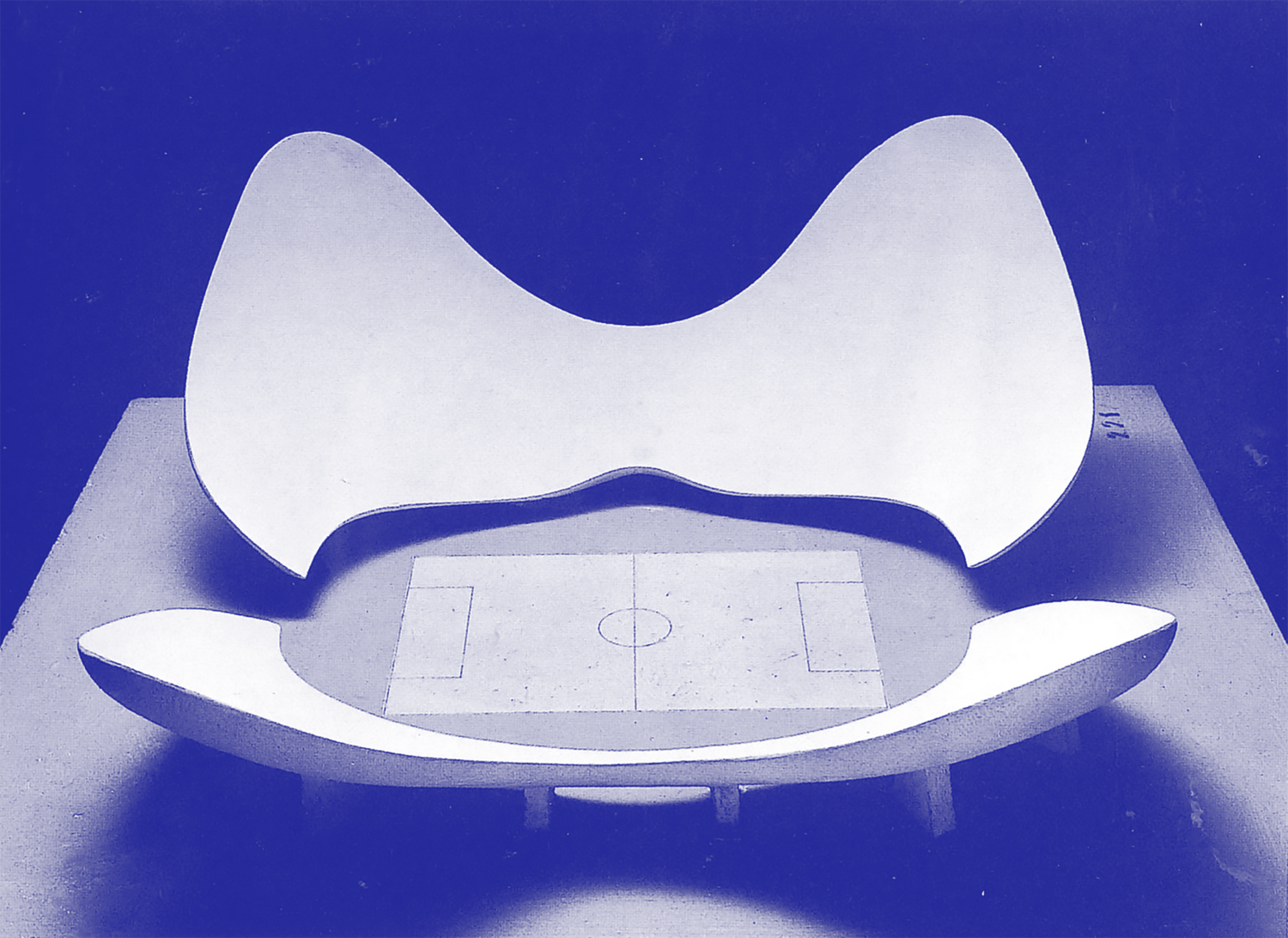
Model of stadium N by Luigi Moretti. Exhibited at the 1960 Parametric Architecture exhibition at the Twelfth Milan Triennial. The stadium derives it’s forms from a parametric model consisting of nineteen different parameters.

The plans for stadium versions M and N showing the equi-desirability curves of the design.
Some pages from Spazio 7, in 1952 investigation the voids of Michelangelo’s San Giovanni dei Fiorentini or from Borromini’s interiors of San Carlino.
Link Moretti, Sturctures and Spaces, 1952
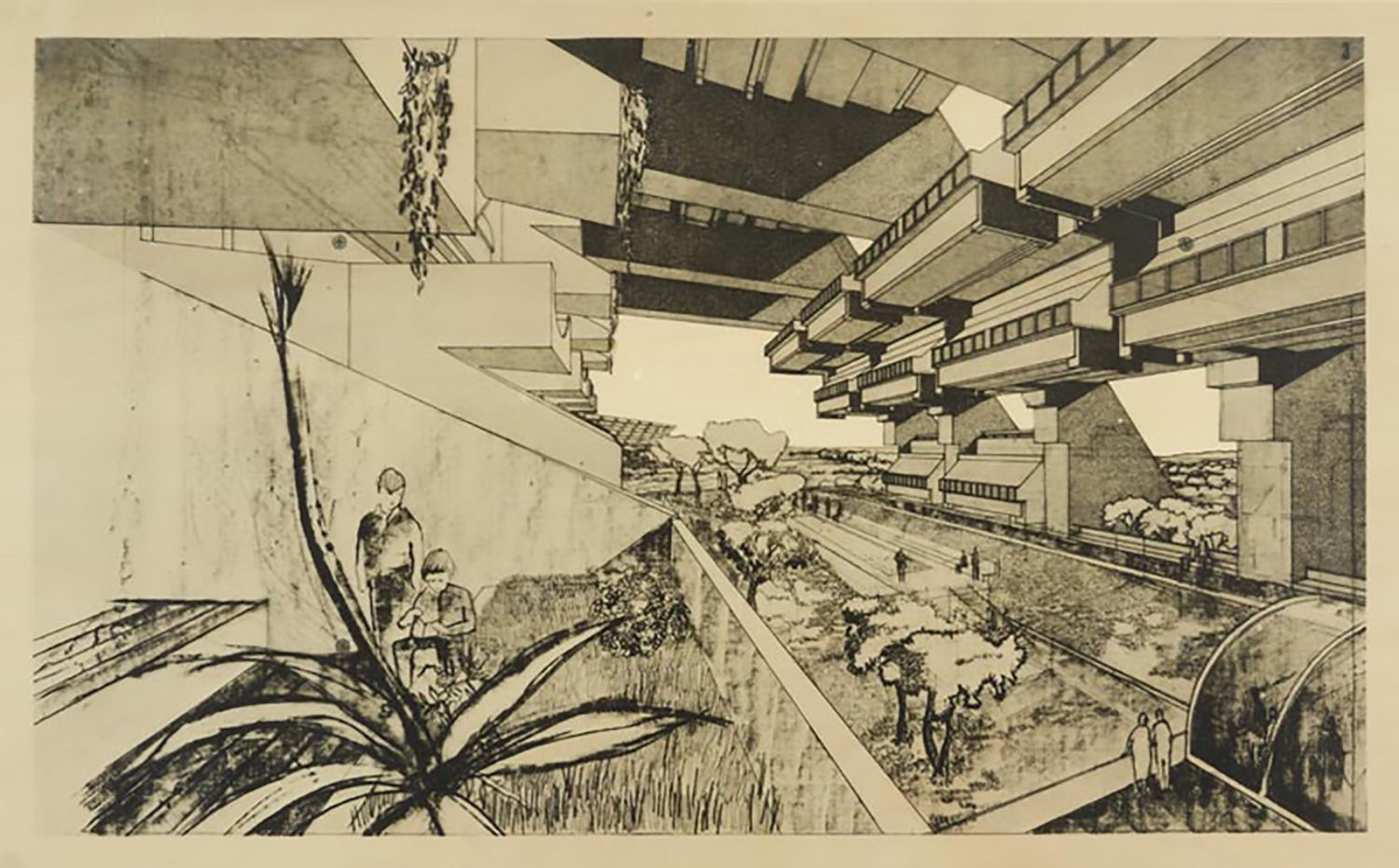
Ricerche su componenti infrastrutturali lineari., 1973 Research on linear infrastructural components, FRAC
Luigi Pellegrin (1925-2001) was born in Courcelette, France. After graduating from Rome, he became one of the major advocates of Organic Architecture in Italy. He met Frank Lloyd Wright when he came to Italy in 1951. Become part of the A.P.A.O. , Association for Organic Architecture founded by Bruno Zevi in Rome in 1945. Soon he develops his original experimental organic architecture in which expressionist, technological and scientific motifs are grafted. Luigi Pellegrin has always highlighted the priority of space-time not as a linguistic choice, but as a specific material of architecture. From the beginning Pellegrin conceived the form as a function of space-time; but later it gave it growth and progressive alteration, identifying the quality with the process of change. This process is legitimized when it recreates an autonomous biological composition between the human community on the planet and its instruments of life, a disalienating symbiosis that Pellegrin found in Louis Sullivan.
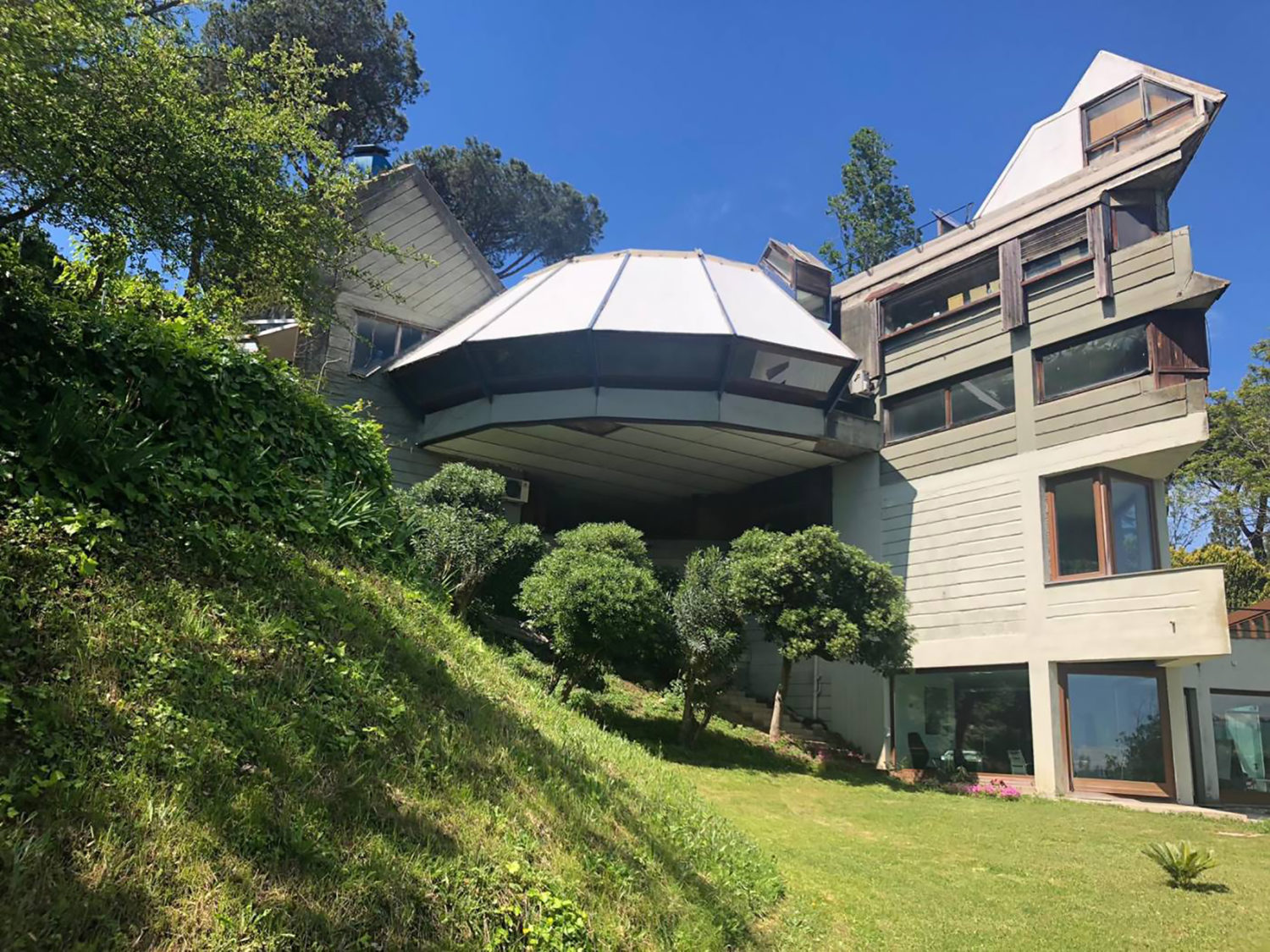
Villa unifamiliare via Aurelia,
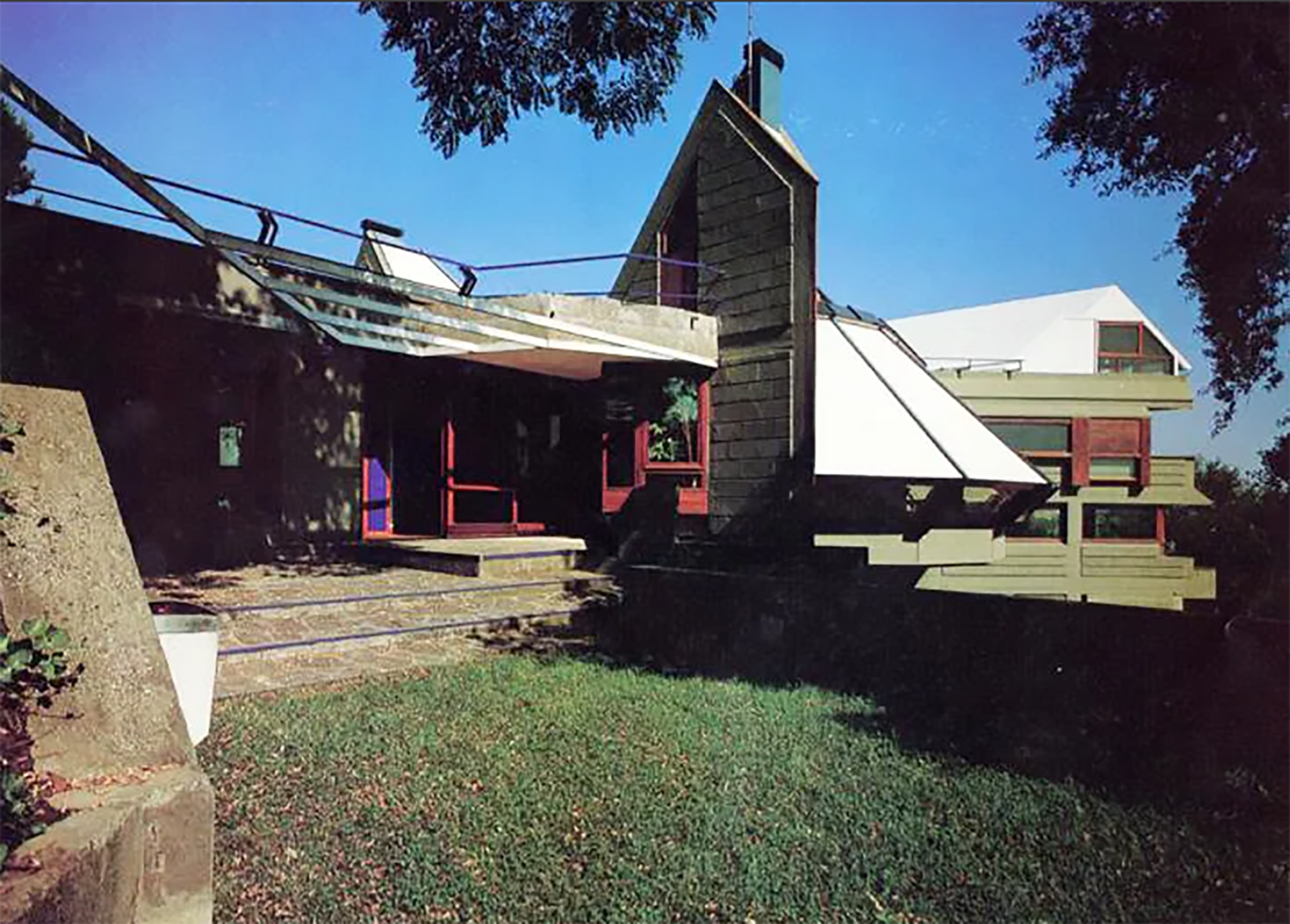
Luigi Pellegrin’s Casa Bifamiliare sull’Aurelia, Rome, Italy, 1964
Pellegrin – Architettura organica sperimentale
Exhibition at the MAXXI, Rome, 25 Apr — 16 Sep 2018
The exhibition Zevi’s Architects. History and Counter-history of Italian Architecture is based on the idea of uniting the figure of Bruno Zevi with a significant work designed by an architect or group of architects whom the great historian and critic supported and appreciated throughout his career. The exhibition, staged in collaboration with the Fondazione Bruno Zevi and curated by Pippo Ciorra and Jean-Louis Cohen (it will be at the MAXXI until 16 September), celebrates the centenary of the birth of one of the most eccentric and multifaceted personalities of the 20th century, a man who was able to combine work as a historian, teacher, architect and designer with the role of politician as well as radio and TV broadcaster. In the exhibition historical and biographical material is interwoven with the drawings, photos and models. The account of his life begins in the pre-war years when he attended the Liceo Classico Tasso in Rome, where he took part in the Littoriali, the artistic and cultural contests organized by the Fascist regime, and joined the leftist group headed by Ruggero Zangrandi where the difficult art of criticizing the regime apparently from within was being honed. After this came years of exile as a result of the racial laws, a university education at Harvard and his return, with the foundation of the Association for Organic Architecture which united a renewal of architecture with the needs of reconstruction.
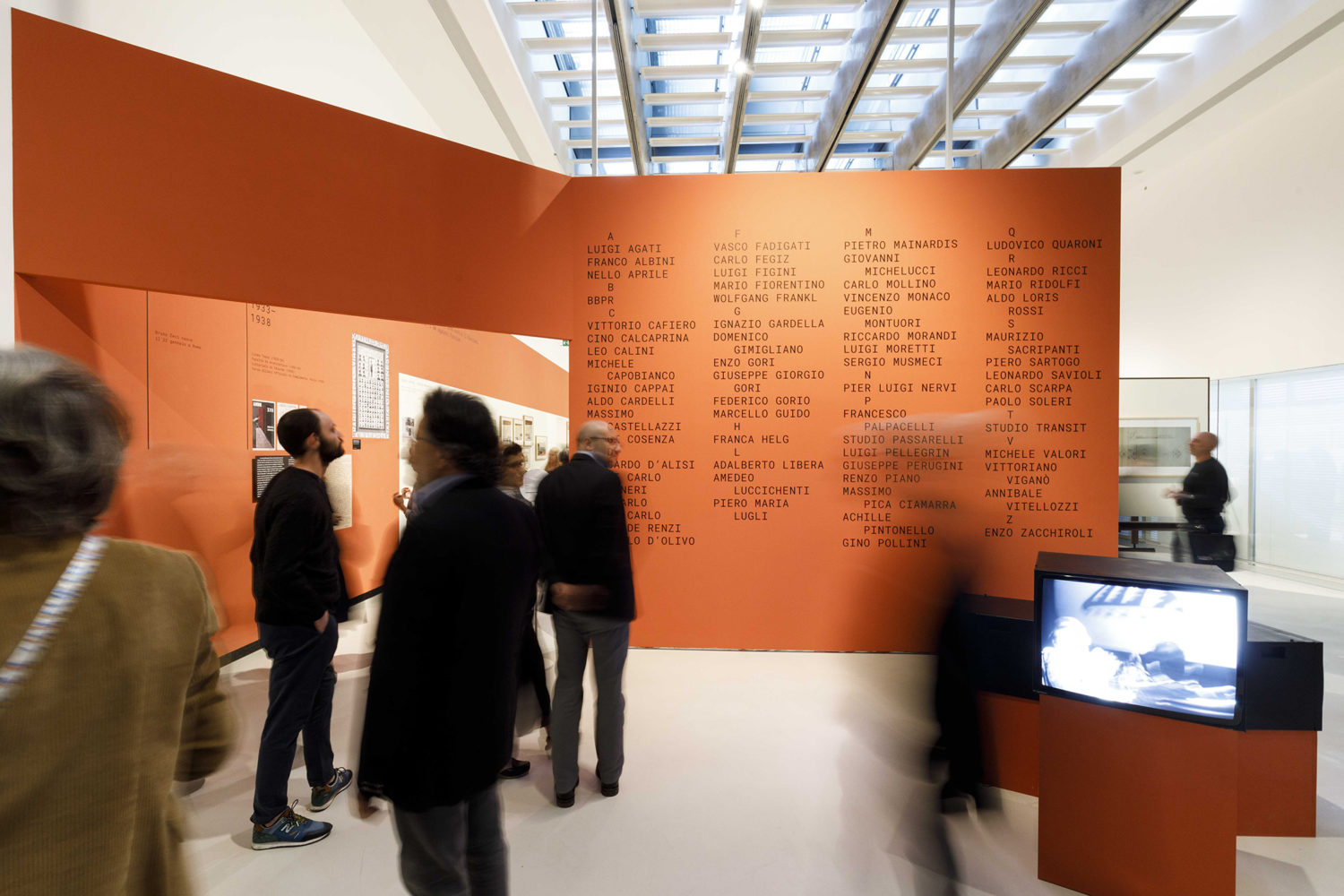
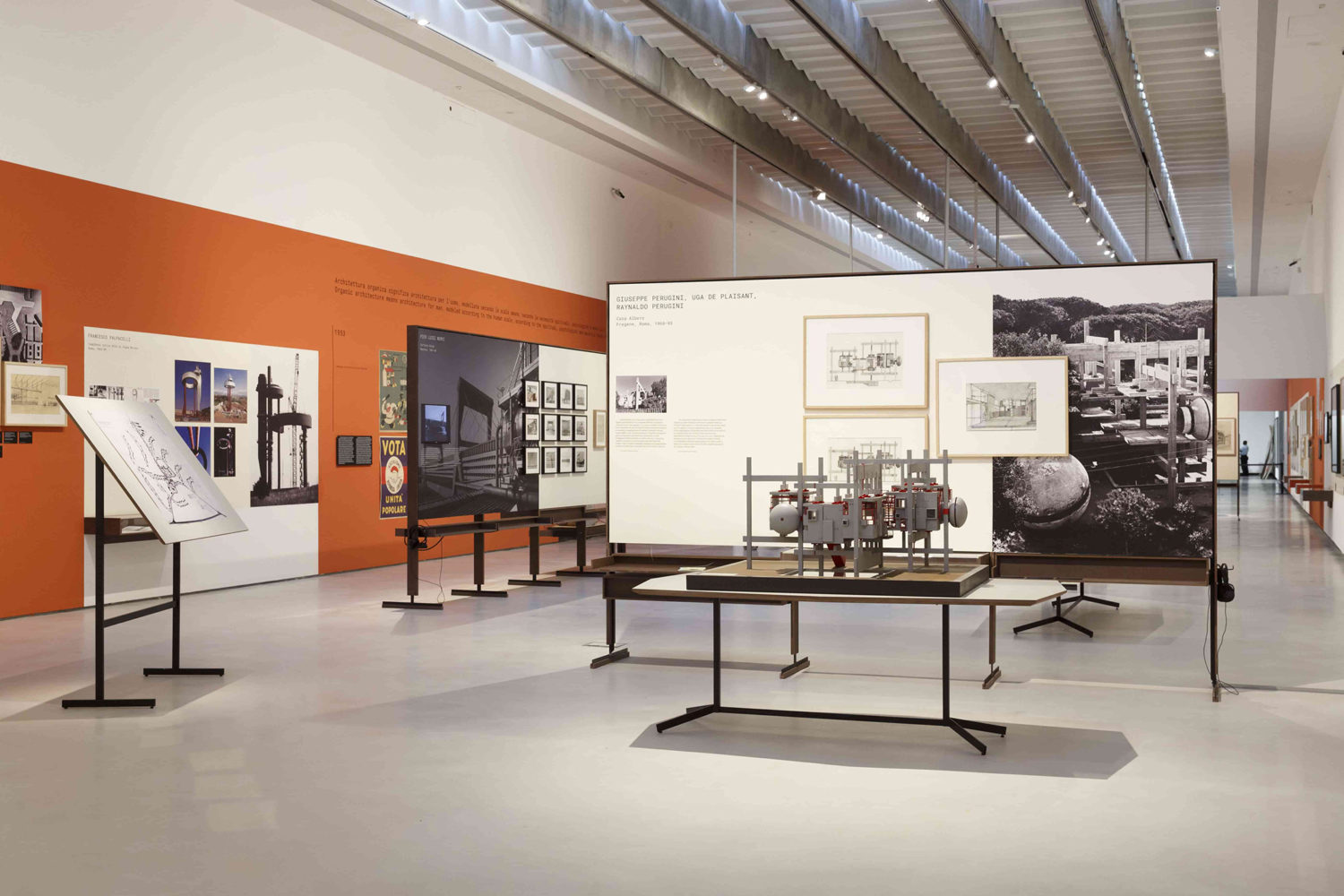
Exhibition book:
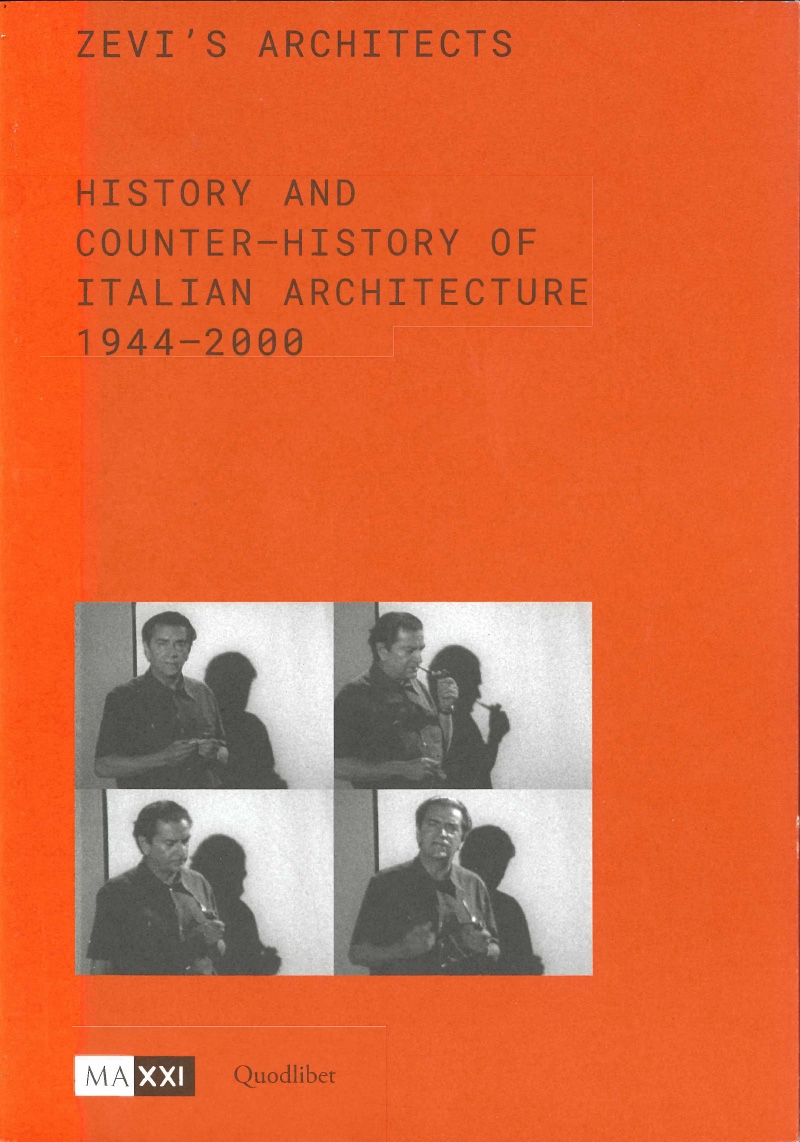
Zevi’s Architects – History and Counter-History of Italian Architecture 1944-2000
List of architects included in the exhibition:
Luigi Agati
Franco Albini
Nello Aprile
BBPR
Vittoria Cafiero
Cino Calcaprina
Leo Calino
Michele Capobianco
Iginio Cappai
Aldo Cardelli
Massio Castellazzi
Luigi Cosenza
Riccardo D’Alisi
Luigi Carlo Daneri
Mario de Renzi
Marcello D’Olivo
VascoFadigatti
Carlo Fegiz
Mario Fiorentino
Wolfgang Frankl
Ignazio Gerdella
Domenci Gimigliano
Enzo Gori
Giuseppe Giorgio Gori
Federico Gordi
Marcello Guido
Franc Helg
Alberto Libera
Ameneo Luccichenti
Pietro Mainardis
Giovanni Michelucci
Carlo Mollino
Vincencio Monaco
Eugenio Montuaori
Riccardo Morandi
Sergio Musmeci
Pier Luigi Nervi
Francesco Palpacelli
Renzo Piano
Massimo Pica Ciamarra
Achille Pintonello
Gino Pollini
Ludovico Quaroni
Leonardo Ricci
Mario Ridolfi
Aldo Loris Rossi
Maurizio Sacripanti
Pietro Sartogo
Carlo Scarpa
Paolo Soleri
Studion Transit
Michele Valori
Vittorano Vigano
Anniblae Vitellozzi
Enzo Zacchiroli
MAXXI Rome – Link to exhibition
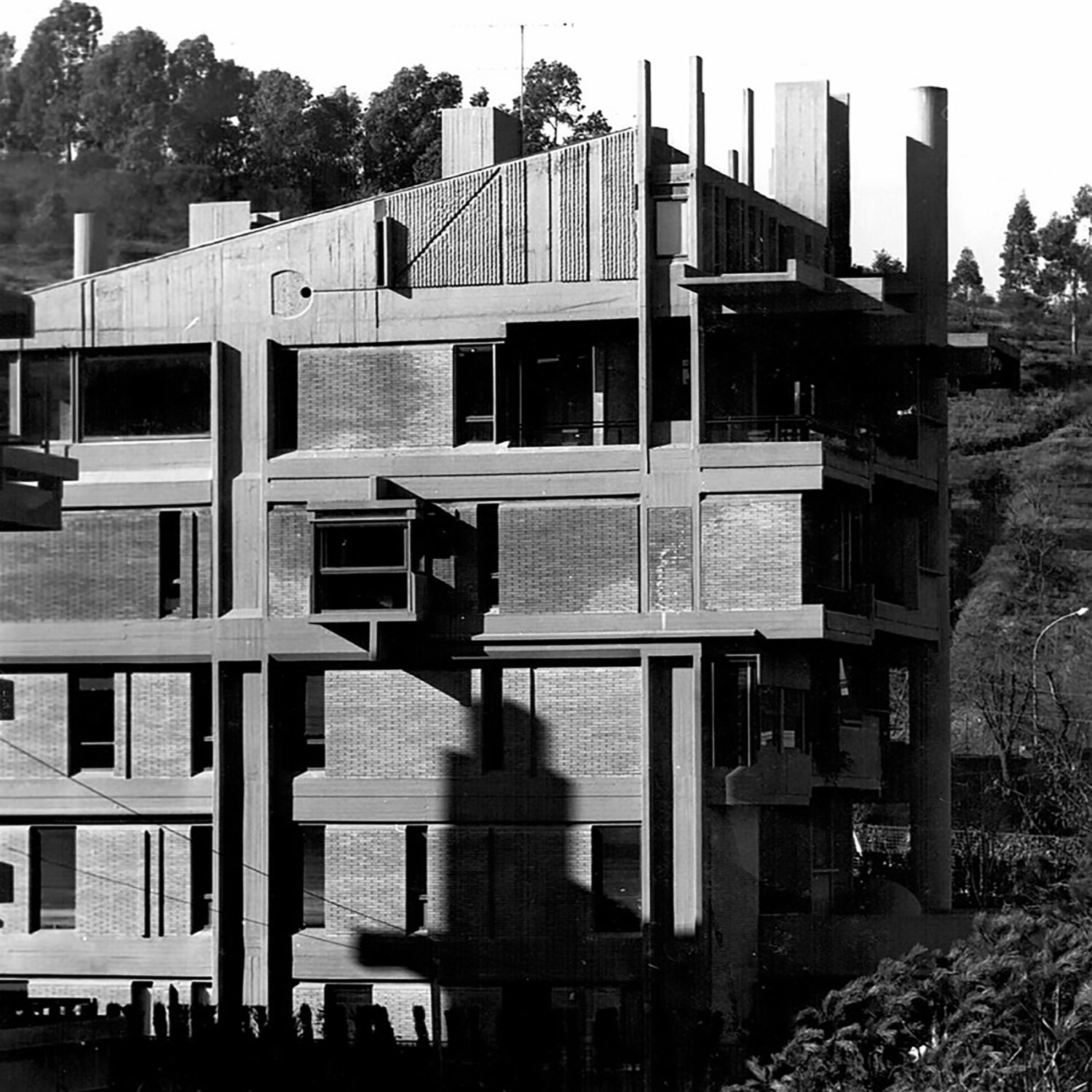
In 1969 the Italian architect Francesco Beraducci (1924-1992) built a small villa in Via Colli della Farnesina, Rome.
Following some spatial organizational ideas from Le Corbusier, he realized the structure as a concrete and brick construction with embedded pre-cast concrete elements. Leaving the main supporting structure exposed some parts of the facade echoes ideas from Kenzo Tange, Paul Rudolph and Mendes de Rocha.
Where Francesco Berarducci develops his personal type interpretation of the “Villino” and a type of housing with individual apartments in a still quite traditional plan layout, the choice of material – concrete, the exposure of an overarching megastructural element, his use of irregular distributed infill elements for the facade – both closed and open or glazed were for him a shift in his architectural language.
He experimented with the integration of greenery into the architecture, he developed a much more fluid and organic approach in the placement of the building within the site context.
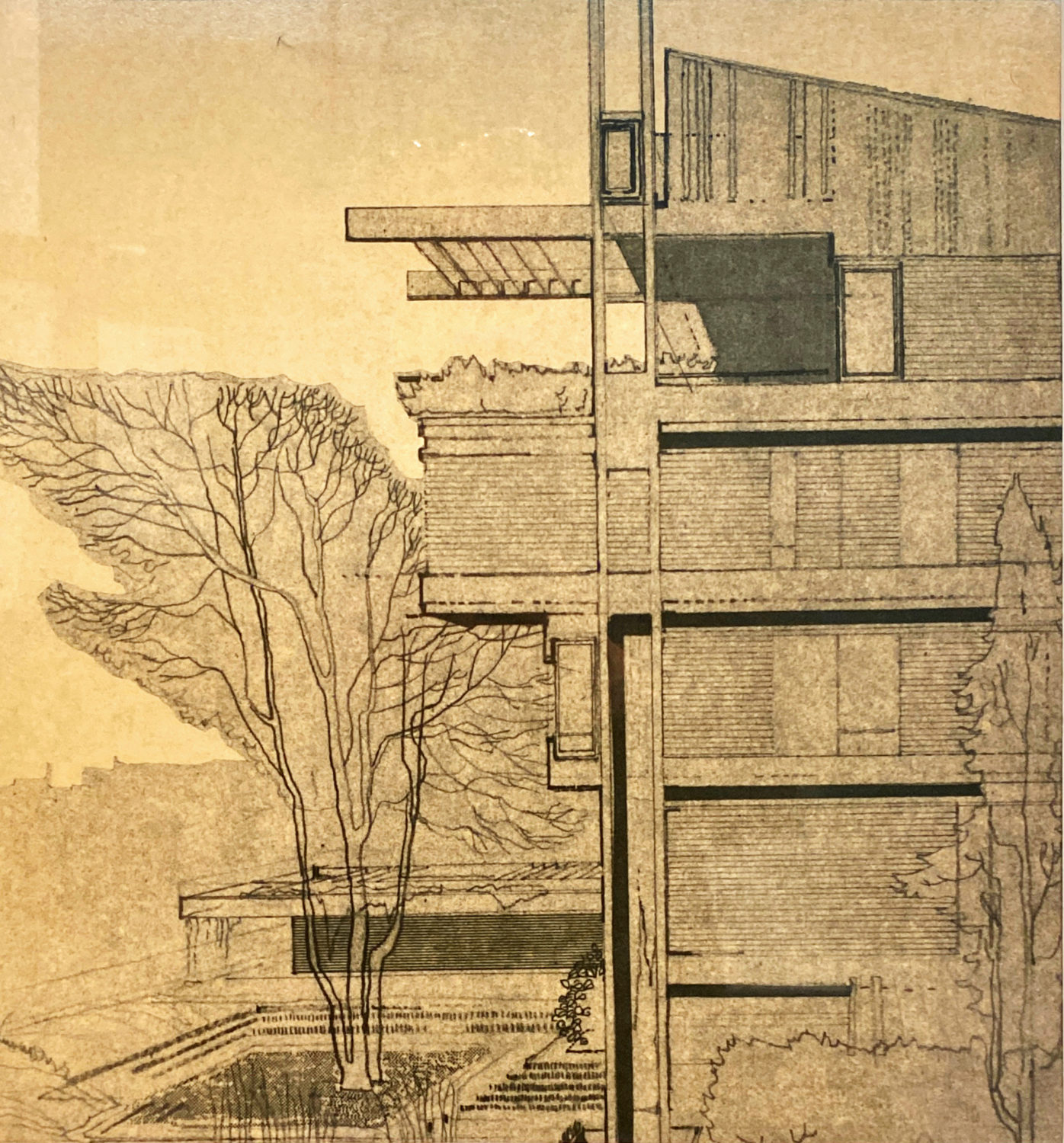
Elevational sketch of the villa in Via Colli della Farnesina.
Rome Brutalist tour LINK
1948
Project of a “Vienna” club in via dei due Macelli, Rome.
1949-1950
API – Gas station AGIP in via Albano, Rome
1950
Villaggio Mommorosa -centro insediativo per sfollati di guerra, Cecina (Toscana)
API – Stazione di servizio, piazza Albania a Roma, Rome
Competition for an auditorium in Naples, Naples
1950-1951
Building typology (shops and apartments) Empoli
Istituto case popolari di Empoli Gestione Ina-Casa
Six Townhouses, Vinci, Vinci (FI)
Istituto case popolari di Empoli Gestione Ina-Casa
Four houses in a village, Vinci Spicchio, Vinci Spicchio (FI)
Istituto case popolari di Empoli Gestione Ina-Casa
Four houses , Montelupo, Montelupo (FI)
Istituto case popolari di Empoli Gestione Ina-Casa
Building, Volterranea, Montespertoli (FI)
Istituto case popolari di Empoli Gestione Ina-Casa
Building, Cerreto Guidi (FI)
Ina-Casa
Building, Certaldo, (FI)
Istituto case popolari di Empoli Gestione Ina-Casa
Building, Castelfiorentino (FI)
Ina-Casa
Building, Colle San Magno (FR)
Ina-Casa
Building, Colle Val D’Elsa (SI)
Ina-Casa
Concorso per il progetto di massima di edifici Ina-Casa in esecuzione del piano incremento occupazione operaia (II anno), Avellino
Ina-Casa
Building, Fucecchio (FI)
Ina-Casa
Building Lastra a Signa (FI)
Ina-Casa
Four houses in Lastra a Signa (FI)
Ina-Casa
Nucleo 5 alloggi nel quartiere Punta di Francia, San Remo
Ina-Casa
Nucleo 7 alloggi in via G. Borea, San Remo
Ina-Casa
Progetto per 8 alloggi, San Remo
Ina-Casa
Building, Arenzano (GE)
Istituto case popolari Genova (Icp Genova)
Edifici posti in via S. Sebastiano e via Cadorna, Rossiglione (GE)
Istituto case popolari Genova (Icp Genova)
Building in Borzonasca (GE)
Istituto case popolari Genova (Icp Genova)
Studio per 8 alloggi da costruirsi nella frazione Cortina Grava (BL)
Istituto case popolari Belluno (Icp Belluno)
Case a schiera: 8 alloggi, Cortina d’Ampezzo (BL)
Istituto case popolari Belluno (Icp Belluno)
Nucleo di 6 alloggi su tre piani, Civitella del Tronto (TE)
S.A.Inps Roma-Gestione Ina-Casa
Nucleo di 3 alloggi su due piani nella frazione Ville Lempa nel comune di Civitella del Tronto (TE)
Ina-Casa
Building Mazzano Romano (RM)
Ina-Casa
Building Anguillara Sabazia (RM)
Ina-Casa
Eight row houses, Cortina d’Ampezzo (BL)
Istituto case popolari Belluno (Icp Belluno)
1951
Buildings in a village in the Comune di Cerreto Guidi (FI)
Istituto case popolari di Empoli Gestione Ina-Casa
1952-1953
National competition for the API service station
Tre fontane e strada 34, Rome
1953-1963
Primary school Villalba Montecelio nel comune di Guidonia (RM)
1954
Study for a church
Project of the parish church, Petacciato (CB)
Sewage and water works, Petacciato (CB)
1955
Reconstruction plan Piedimonte San Germano, (FR)
Amministrazione di Piedimone San Germano
1956
Competition for the Fermi Memorial, Chicago, USA
With C. Parolini, T. Valle
Church, Piedimonte s. Germano (FR)
Invited competition for the Italian Pavilion at the Expo1958 in Bruxelles, Belgium
With BBPR, I. Gardella, L. Quaroni e A. De Carlo
1956-1959
Buildings for the Ina Casa district, Rome
With E. Del Debbio, U. de Plaisant, F. Dinelli e F. Girardi
Ina-Casa
1957
National competition for the Palace of Justice, Bari
1958-1961
Hotel Raphael: restoration and renovation, Rome
1959-1962
National competition for the judicial city of Rome.
With V. De Feo, U. de Plaisant, M. Nicoletti, E. Giangreco e N. Monteduro
1960
API – Service station
With E. Del Debbio, U. de Plaisant, F. Dinelli e F. Girardi
Ina-Casa
Progetto ” Service station”
API – Service station in via Palombella, Ancona
API – Renovation of offices in corso Italia, Ancona
API – Cooperativa in via Asmara, Roma
API- Service station Agip, Pesaro
API – Intervention on existing building, Viterbo
API – Service station in via Casilina, Roma
API – Service station, Terni
API – Service station, Avezzano
API – Service station, Foligno (PG)
API – chioschi. Chiosco a Napoli; chiosco all’Eur, Roma; progetto di un chiosco in via Aurelia, Roma; chiosco non identificato, Naples
API – Service station
Supermaket sulla Cristoforo Colombo, Rome
1961
Experimental building project,
With C. Ciribini, E. Giangreco, M. Parolini
1964-1965
Project for a church in the pine forest, Fregene, (RM)
With I. Ailardi
New housing development in the neighborhood Tre Fontane, Rome,
M. Fiorentino, O. Gargano, G. Vaccaro (project coordinator), T. Valle, consulenza generale: R. Neutra
Ministero del tesoro e Direzione generale istituti di previdenza
1964-1967
Service facility along the highway del Sole (area di servizio Fabro), Ancona
1965-1972
Residential building, Arcinazzo, (RM)
With R. Perugini
1966-1967
Casa Perugini, Fregene,
With U. de Plaisant e R. Perugini
1967
Competition for the exhibition set-up in the Fortezza di Basso, Firenze (FI)
Ente Mostra mercato internazionale dell’artigianato
Inarch-Finsider competition for experimentation in steel design,
With U. de Plaisant
1967-1979
Tratto autostradale Resuttano-Enna lungo l’autostrada Palermo-Catania
1967-1968
National competition for new ecclesiastical typologies: Chiesa nel quartiere Primavalle, Rome
With G. T. Tonelli
1967
Competition for the Unido headquarters, Vienna,
With U. de Plaisant
National competition for the new cybernetic hospital in the neighborhood Pietralata, Rome,
With U. de Plaisant, A. Tonelli, G. Tonelli
1968
National competition for the urban planning of the Caffarella Valley in Rome,
With A. Tonelli and G. Tonelli
1969
Service station, Milan
Provincia di Milano e AGIP
Delta hotel in via Labicana, Rome
With G. Tonelli
Bridge across the Strait di Messina,
With U. de Plaisant, V. de Benedetti, G. Mennocci
Competition, not completed, for the Palace of Justice, Naples,
1971
International competition for the multipurpose center of Plateau Beaubourg, Paris,
O.C. Cacoub, R. Heim de Balsac, G. G. de Rossi, R. Perugini, Y. Roa
1973
Partial restructuring and restoration project of compartment no. 34 between Corso Garibaldi
Corso Mazzini – piazza della Repubblica, Ancona
With A. Roccetti
1974-1975
Mosque in Rome,
C. Longo e A. Bouzira
1975
Competition for the business center: national competition for the planivolumetric design of a business area located in the Florentine territory within the central metropolitan area of Florence
With F. Malusardi, G. Bianchi, R. Bracci, R. Perugini
1976-1981
Contract-competition for the buildings of the Filippo Turati social housing consortium in the Laurentino area, RomeWith C. Chiarini, C. Michelangelo, S. Pasanise
1979-1982
Restoration of the seventeenth-century Muti-Bussi palace near Piazza Venezia, Rome
1983
International La Défense competition in Paris,
With R. Heim de Balsac, R. Perugini and others.
1983-1989
Restoration of the monumental complex of Villa Mondragone, Monteporzio Catone (RM)
1986
Competition for the executive design and contract of the new headquarters of the Cassa di Risparmio di Jesi (AN)
With R. Perugini, B. Begnotti, Rolletti
1987
International competition for the expansion of Turin Caselle airport, Torino
With G. Tonelli, R. Perugini
1987-1989
Redevelopment of the main stations in Verona
1987-1991
Renovation of the town hall, Celano (AQ)
With S. Nicoletti, P. Micalizzi, R. Perugini
1988
Proposal for the construction of an integrated shopping center in Le Torri a Cintola, Firenze
With Moreno Paolo Torri, P. Micalizzi, S. Nicoletti, R. Perugini
Outpatient clinic project and Local Health Unit 53, Corleone (PA)
With R. Perugini
Study – design of the structures of the railway junction, Verona
With G. Valle, R. Perugini
1989
Cultural centre, Forte dei Marmi, (LU)
1991
Monument for Natalino Sapegno,[Aosta]
Feasibility plan for the new university, Cassion (FR)
Master plan for Ciampino
With R. Perugini
Master plan for Racalmuto in the Agrigento area, Racalmuto (AG)
Master plan for Castelverde, (CR)
Master plan for Roma
Master plan for Castel Madama (RM)
Master plan for Macerata
No dates
Appartamenti Peretti, Ancona
Casa Arioni (arredo) in piazza Quiriti, Rome
Tangenziale, Arezzo
With R. Perugini
Competition for the Palace of Justice in the former Caproni building in the Borgo Pineta district, Avezzano
Competition of ideas for the design of an urban ring road, Arezzo
Project of reworking the elevations of the building of the società F. I. -Cattapirone
Extension Casa Janaki, Corfù
Extension Casa del sindaco, Celano
Restauration Casa Morricone all’Ara Coeli, Roma
Casa -albergo dell’onorevole (ristrutturazione), Perugia
Extension casa Di Geso, Ardea
Restauration Casa Sapegno in piazza del Gesù, Roma
Solunto
Villa dell’amico di Sergio Rossi, Albano laziale
Casa Teofili in viale Cassia, Roma
Casa Rizzi in viale Cassia, Roma
Casa Meniconi e Cerbello in via della Massimilla, Roma
Casa bifamiliare sulla provinciale Nettuno-Cisterna, Roma
House extension in via Appia antica, Roma
Casa Tonelli
Internal changes to the house of the director of the National Bank of Agriculture, Terni
Restauration Casa Padovani-Lemmi, Empoli
Competition for the Centocelle park in Rome
Church project, Petacciato
Casa for Donati Delio, Fregene
River cooperatives
G.B.R
With R. Perugini
Competition contract for the construction of a public residential building project in the Spinaceto district, Roma
Istituto autonomo per le case popolari (Iacp)
Project for the Cariplo headquarters, Jesi
Houses for workers in the Pegli district, Genova
Ina-Casa
Office redesign in via Milano, Bolzano
Competition contract (Navarra) for the extension of the regional headquarters, L’Aquila
Villa Gentile (ampliamento II Università), Rome
Fruit market
Renovation of a basement for public use
Duomo, Orvieto
Casa Padovani, Empoli
Restoration project of Casa Perugini in via della Dogana vecchia- 11, Roma
Renovation of a former farmhouse in piazza Martignana, Firenze
Casa P in via Traversari – 51, Roma
Teatro di Pirandello
Tabaccheria Reali: vetrina
Edilizia residenziale: alloggi, Rocca Santo Stefano (RM)
Studi of a tombe
Cappella Colognese
Cappella al Verano (Delle Monache?)
Cappella Lamberti, Calascibetta
Tomba romani
Cappella Salvatori
Cappella Savelli al Verano, Rome
Casa Cianci, Termoli
Pizzo, Termoli
Stazione di Termoli
Parco nel quartiere Trullo, Termoli
Piazza del Papa, Termoli
With R. Perugini
Master plan per Termoli
With R. Perugini
Fabbricato residenziale n. 3
Parco nel quartiere Trullo, Roma
[Progetto di palazzina], Viterbo
Project for the Università, Salerno
Università di Faenza (SA)
Unidentified project in the Fregene area -Maccarese )RM)
Survey dell’Aniacap
Angrisani: Ampliamento di un centro di recupero per handicappati
Project for a refreshment point, Terracina
Cartografia: Novara (Piano regolatore generale )
Cartografia (varie località): Milano, Maccarese, Bari
Raccolta di cartografie e piante catastali di Roma
Cartografia su Roma
Cartografia sulla Sicilia
Progetto per una sedia
Concorso per il Parlamento, [Roma]
Casa Borzi sul Gianicolo, Rome
Casa Cacchione
Ministero della guerra, [Rome
Camera dei deputati, Roma
Prato dei diamanti
Osaka
Ospedale, Empoli
Università della Calabria
Paride
Gerini
Perugini, G.
La forma in architettura. Appunti per una metodologia del rilievo, Perugini, G., A. Conti, Rome, 1953
Modelli Borrominiani, in S. Giovanni dei Fiorentini, Perugini, G., Università di Roma, Rome, 1962
Il Campidoglio di Michelangelo, rilievi a cura di Enrico Del Debbio e Perugini G., fotografie di Leonard Von Matt – Guglielmo De Angelis d’Ossat, Silvana, Rome 1965
Architettura sovietica della rivoluzione: manifesti documenti contributi : informazione sugli anni 1910-20 in U.r.s.s, Perugini, G., Edizione Nuova Dimensione, Rome, 1969
Perchè Loos, Perugini G., Rome, 1970
Progetti e ricerca, Perugini G., Edizione Nuova Dimensione, Rome, 1975
La Casa Albero. Un esperimento di architettura, Perugini, R.; Perugini, G., Ginevra Bentivoglio EditoriA, 2018
De Plaisant, U.
Le Iconi d’Oggi, De Plaisant, U., Bulzoni, 1975
Perugini, R.
La memoria creativa, Perugini, R., Officina 1985
Periplo architettonico. Saggi su teoria, pensiero e progetto nella storia dell’architettura moderna e contemporanea, Perugini, R., Ginevra Bentivoglio EditoriA, 2008
La lezione della storia. Architetti e contesti tra antichità classica e tardo Rinascimento, Peruggini, R., Ginevra Bentivoglio EditoriA, 2015
La casa albero. Un esperimento di architettura, Perugini, R.; Perugini, G., Ginevra Bentivoglio EditoriA, 2018
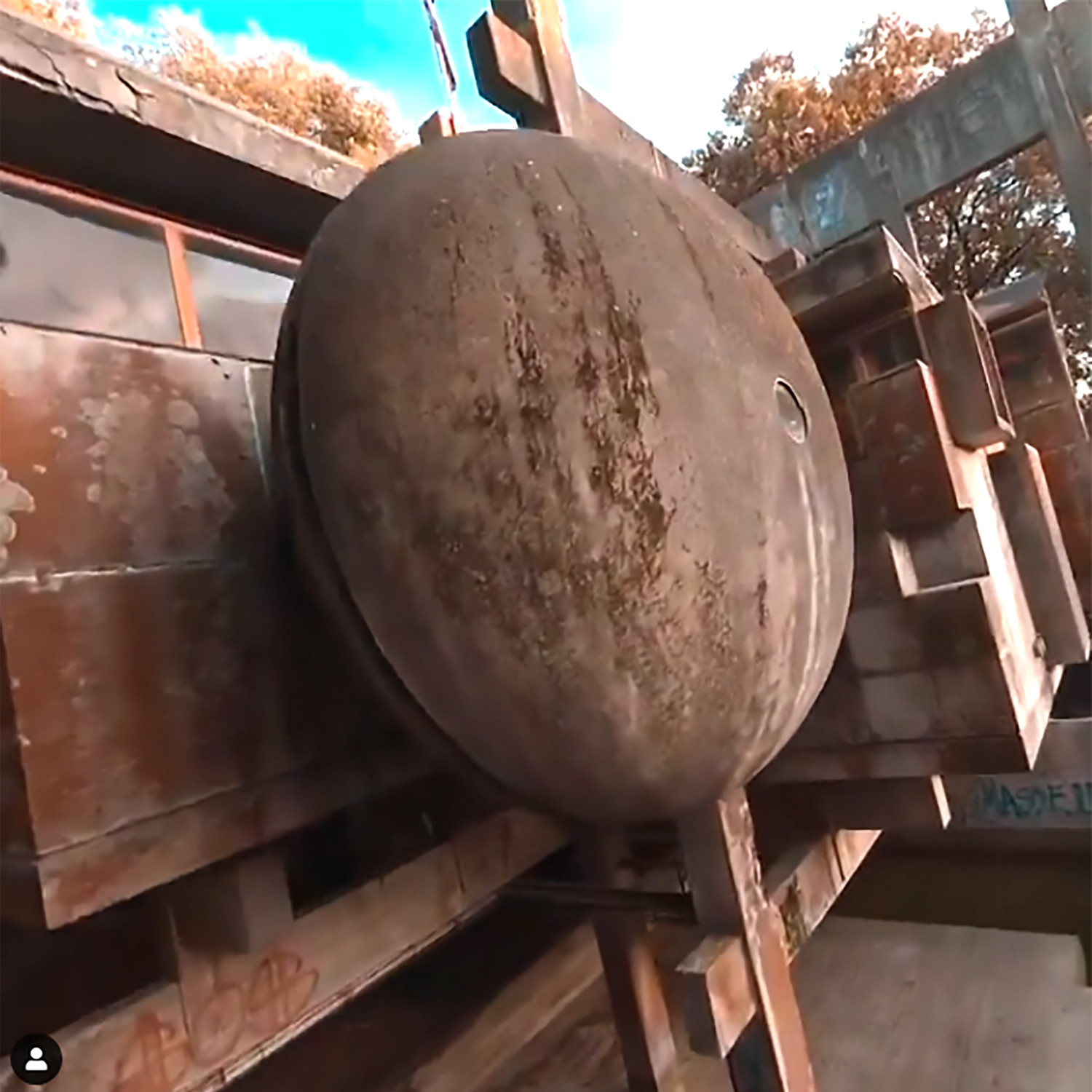
This amazing film by the professional drone pilot Nils Astrologo has been posted on Instagram.
Or here on YouTube LINK
.
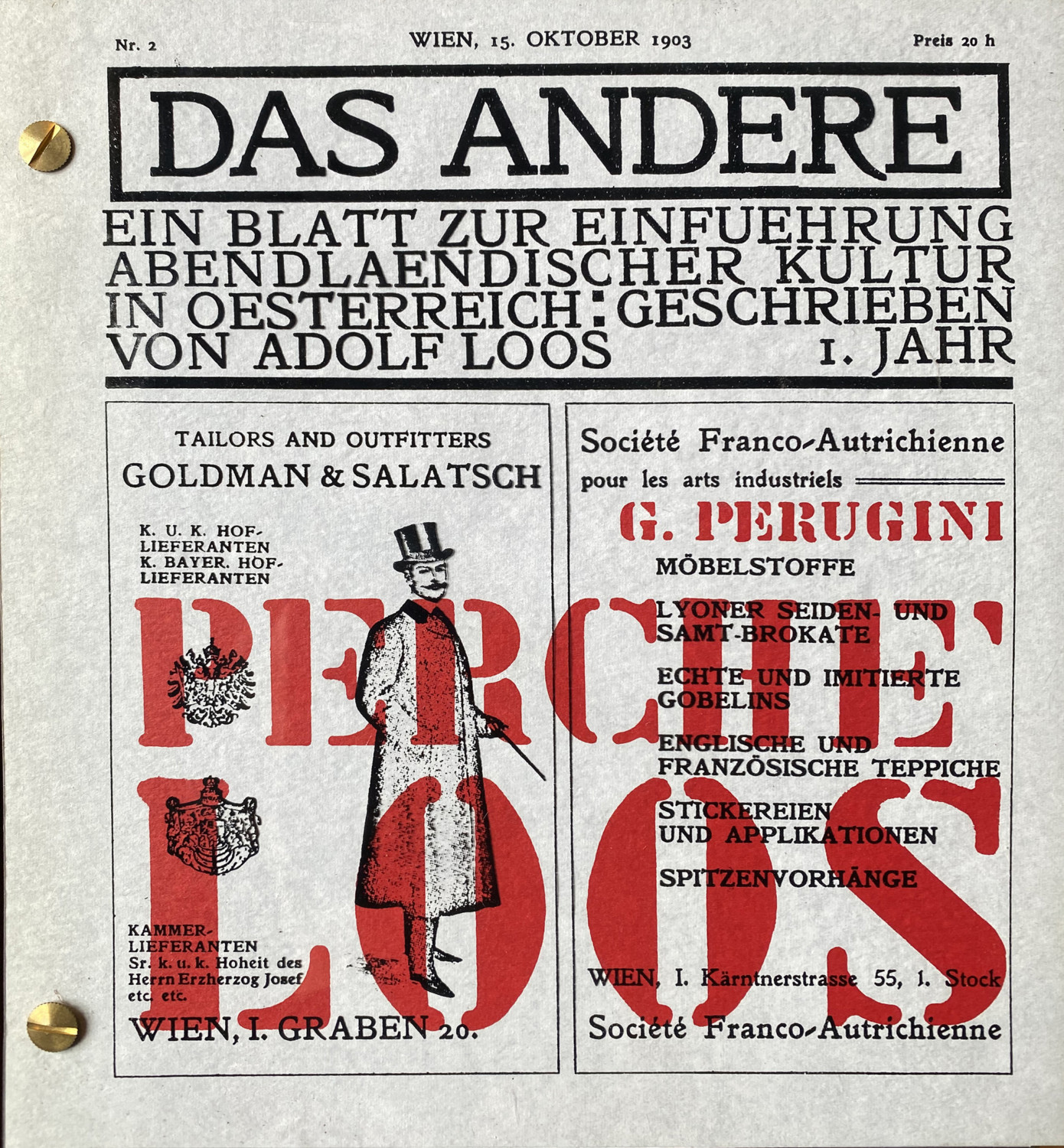
Book published by in 1970.
by Giuseppe Perugini; Claudio Bertolini; Massimo Nobilioni
Perché Loos
Available in:
Zentralinstitut für Kunstgeschichte, Bibliothek
Università degli Studi Roma TRE- Sistema Bibliotecario di Ateneo
